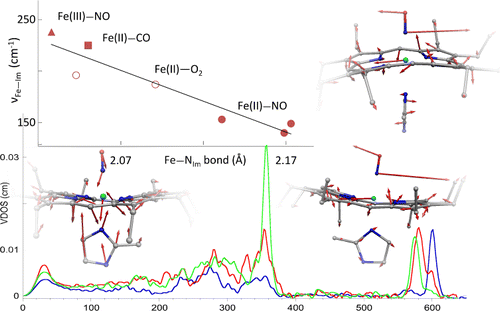Jianfeng Li *†‡, Qian Peng‡, Allen G. Oliver‡, E. Ercan Alp§, Michael Y. Hu§, Jiyong Zhao§, J. Timothy Sage*∥, and W. Robert Scheidt*‡

Oriented single-crystal nuclear resonance vibrational spectroscopy (NRVS) has been used to obtain all iron vibrations in two {FeNO}6 porphyrinate complexes, five-coordinate [Fe(OEP)(NO)]ClO4 and six-coordinate [Fe(OEP)(2-MeHIm)(NO)]ClO4. A new crystal structure was required for measurements of [Fe(OEP)(2-MeHIm)(NO)]ClO4, and the new structure is reported herein. Single crystals of both complexes were oriented to be either parallel or perpendicular to the porphyrin plane and/or axial imidazole ligand plane. Thus, the FeNO bending and stretching modes can now be unambiguously assigned; the pattern of shifts in frequency as a function of coordination number can also be determined. The pattern is quite distinct from those found for CO or {FeNO}7 heme species. This is the result of unchanging Fe–NNO bonding interactions in the {FeNO}6 species, in distinct contrast to the other diatomic ligand species. DFT calculations were also used to obtain detailed predictions of vibrational modes. Predictions were consistent with the intensity and character found in the experimental spectra. The NRVS data allow the assignment and observation of the challenging to obtain Fe–Im stretch in six-coordinate heme derivatives. NRVS data for this and related six-coordinate hemes with the diatomic ligands CO, NO, and O2 reveal a strong correlation between the Fe–Im stretch and Fe–NIm bond distance that is detailed for the first time.